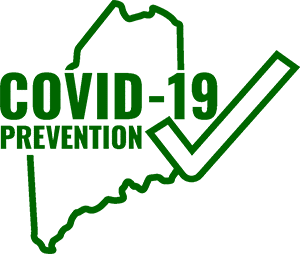 Employees Required:
Employees Required:
• Face Coverings: Require employees to wear cloth face coverings.
• Hand Hygiene: Remind employees to practice good hand hygiene with frequent handwashing and hand sanitizing especially between contact with guests and guest items.
• Ensure employees stay 6 feet apart whenever practical.
• Prohibit gatherings or meetings of employees of 10 or more during working hours.
• Limit interaction between employees and outside visitors or delivery drivers; implement touchless receiving practices if possible.
• Limit sharing of handheld equipment, phones, desks, workstations, and other tools and equipment between employees to the extent possible.
• Do not allow employee food or drink in food service areas.
• Training: Provide employee training for:
o Physical distancing guidelines and expectations
o Monitoring personal health
o Proper wear, removal disposal of Personal Protective Equipment (PPE)
o Laundering of face coverings and uniforms as listed below
o Cleaning protocols as listed below
o How to monitor personal health and body temperature at home
o Guidance on how to launder cloth face coverings and uniforms: see CDC, Cleaning and Disinfecting Your Facility, How to Disinfect: Laundry
o Cleaning protocol, including how to safely and effectively use cleaning supplies.
Recommended:
• Where possible, stagger employee shifts and meal breaks to avoid crowding in common work areas.
• Adjust seating in break rooms and other common areas to reflect physical distancing protocols.
• Permit employees to take breaks and lunch outside, or in such other areas where physical distancing is attainable.
• Adjust training and new employee orientation to limit number of people involved and allow for 6 foot spacing; use virtual/video/audio training when possible.
• Consider employee training in safe de-escalation techniques.
• Entertainment personnel should follow the same physical distancing and cloth face covering guidelines as other employees.
Customers Required:
• Guest visitation restricted to Maine residents and out of state visitors who have met the 14-day
quarantine requirement as well as out of state essential workers at this time per executive order.
• Call ahead or online reservations are required.
• Signage: Place signage at entrances and throughout the lodging establishment alerting customers to
COVID policies especially to maintain 6 feet physical distance to the extent possible.
• Face Coverings: Require customers to wear cloth face coverings. This is especially important when social distancing is difficult (e.g. waiting in line for registration, entering or exiting, walking to the restrooms).
• Contact Tracing: Maintain records of customers, including one customer name and contact information per party and the server of the table to enable contact tracing.
• Limit restroom occupancy for groups restrooms to incorporate physical distancing and avoid formation of waiting lines outside of restrooms.
• Breakfast: No buffets or self-service areas with multi-use items. Breakfast service should be packaged as “grab and go”. If you have a restaurant – all service should adhere to the restaurant re-opening checklist.
• Group Size is limited per executive order.
Recommended:
• Inform guests of your COVID policies in advance, if possible.
• Minimize other self-service areas such as drink stations. To the extent possible, use contact-less dispensers to minimize hand touching. Replace multi-use condiments with single-serve packets. Other suggestions to minimize multi-touch surfaces include providing single-wrap utensils, straws, and lids provided at any takeout or self-seating of sale. Self-service areas require frequent cleaning and disinfection.
• Self-service dispensers for coffee, drinks, juice, and ice should be routinely cleaned or discontinued at this time.
• See Restaurant Guidance for restaurants on site.
Operations Required:
- Curtail use of exercise facilities until reopening guidance is issued.
- Practice enhanced room sanitation by cleaning and sanitizing all hard services after every use.
- Launder linens, bedspreads and covers after every use.
- Guest rooms will be left vacant for a period of time following each departure, to allow for deep cleaning, disinfectant and cleaners to dry, and reasonable air exchange. Consider ways to maximize airflow, if practical, to increase fresh air circulation (e.g. openings windows, or doors).
- Advise contractors, drivers, and vendors that they are required by Executive Order #49 to wear cloth face coverings while on the premises.
- Require regular and frequent sanitization of high-touch areas like restrooms, handrails, doors, PIN pads, and common areas that are accessible to staff, guests and suppliers.
- Provide sanitization materials, such as sanitizing wipes, to employees to clean handhelds/wearables or other work tools and equipment before/after use.
- Hand sanitizer: Provide hand sanitizer in public areas for guest and employee use.
- Remove pen, paper and guest directory, magazines and brochures; supplement with digital or available upon request.
- Contact Tracing: For contact tracing purposes, establishments should maintain a record including contact information for clients, and those personnel who had direct interaction with them. o Hotels should maintain records that will help trace contacts of any infected individuals that have been to the hotel property. Review and implement a record keeping process to maintain records of guest and staff movement.
- Restaurant on site: Follow restaurant guidance for restaurants on site (including B&B breakfast service). Room Service is encouraged.
Recommended:
- Widen high-traffic areas to the extent possible.
- Note that staff or customer use of elevators or escalators will require regular attention to physical distance guidelines and frequent cleaning of high-touch surfaces.
- Minimize shared touch surfaces such as kiosk, tablets, pens, credit cards, receipts and keys.
- Establish protocols for handling and processing shipping and receipts (including disinfection).
- Notify vendors of re-opening, and any revised protocol as it relates to store entry, deliveries, paperwork, etc.
- Consider implementing measures to ensure vendor safety, including: o Disabling/suspending access (e.g., suspending all non-employee delivery drivers from entering restaurant).
- Transitioning to contactless signatures/e-signatures for deliveries.
- Where practical, adjusting store delivery times to spread out deliveries.
- Request that vendors direct their employees to follow all social distancing guidelines and health directives issued by the applicable public authorities.
- Consider providing cleaning “kits” including disinfectant wipes or sprays, disposable gloves, paper towels, cloth face coverings, hand sanitizer and other cleaning supplies that are readily accessible throughout the restaurant for areas that will be cleaned periodically throughout the day.
- Note that areas of cleaning focus for general hotel areas include:
o Door and drawer handles
o Light and other power switches (consider signage to keep lights on at all times, or utilizing exiting motion sensor capabilities
o Shared tools
o Chairs, tables, and benches
o Refrigerators, microwave, and other frequently touched objects and surfaces in service areas
o Time clocks
o Entry way
o Cash register, including touch screens, keyboards, mouse
o PIN pads (touch screen, keypad, and pen)
Restrooms
▪ Toilet bowl, toilet paper holder, and flush lever
▪ Sinks and faucets
▪ Paper towel holders and/or air dryers
▪ Diaper changing stations
- Note that vending machines are not recommended at this time.
- Automatic ice self-dispensing machines are acceptable.
Sales Required:
• Promote “Contactless” payment options.
• Wash hands or use alcohol-based hand sanitizer (at least 60% alcohol) after handling cash.
Recommended:
• Consider adding physical barriers such as partitions or plexiglass barriers at registers.



